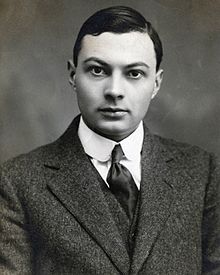László Hudec
| László Hudec | |
|---|---|

László Hudec
|
|
| Born |
January 8, 1893 Besztercebánya, Austria-Hungary (today Banská Bystrica, Slovakia) |
| Died | October 26, 1958 (aged 65) Berkeley, California, United States |
| Nationality | Hungarian, Slovak |
| Other names | Ladislav/László/Ladislaus/Ladislaw Hudec |
| Citizenship |
Hungarian (1893-1921) Czechoslovak (1921-1941) Hungarian (1941-) |
| Alma mater | Budapest University |
| Occupation | Architect |
| Spouse(s) | Gizella Mayer |
| Buildings | Park Hotel Shanghai (more...) |
László Ede Hudec or Ladislav Hudec (Hungarian: Hugyecz László Ede) (Banská Bystrica, Austria-Hungary January 8, 1893 – Berkeley, October 26, 1958) was a Hungarian–Slovak architect active in Shanghai from 1918 to 1945 and responsible for some of that city's most notable structures. Major works include the Park Hotel, the Grand Theater, the Joint Savings and Loan building, the combined Baptist Publications and Christian Literature Society buildings, and the post-modern "Green House". Hudec's style evolved during his active period, from the eclectic neo-classicism popular in the early 20th century to art deco and modern buildings toward the later part of his career. Although some of his buildings have been lost in the intervening decades, many survive.
Hudec was born in 1893 in Besztercebánya, Kingdom of Hungary, Austria-Hungary (now Banská Bystrica in Slovakia). His father, György Hugyecz was a wealthy MagyarizedSlovak architect, born in the nearby village of Felsőmicsinye (now Horná Mičiná), while his mother, Paula Skultéty was an ethnic Hungarian from Košice (Kassa). He studied architecture at Budapest University from 1911 to 1914. As a patriotic Austro-Hungarian citizen, Hudec volunteered to join the Austro-Hungarian Army after outbreak of World War I, but was captured by the Russian Army in 1916 and was sent to a prison camp in Siberia. While being transferred, he jumped from a train near the Chinese border and made his way to Shanghai, where he joined the American architectural office R.A. Curry.
...
Wikipedia
